Exercise and histamine intolerance – is it safe to work out when you have it? Also, can exercise help histamine intolerance symptoms?
Exercise is part of a healthy lifestyle. Working out regularly has many mental and physical health benefits that are hard to ignore. Plus, the health benefits are numerous and cumulative.
By working up a sweat, you strengthen your heart, lower your blood pressure, improve your body composition, and even improve your mental health.
Working out clears your mind too, and it even gives your cognition a boost. Best of all, studies show that exercise lowers the risk of early mortality. (“Physical Activity at Any Intensity Linked to Lower Risk of Early Death | BMJ” 2021)
Who wouldn’t want benefits like that? However, we each have a different response to exercise.
If you suffer from histamine intolerance, can exercise help, or are there any downsides to working out? When you suffer from histamine intolerance, the last thing you want is to worsen your symptoms.
Let’s examine what science has to say about exercise and histamine intolerance and whether it’s safe to work up a sweat when you have problems breaking down histamine.
Histamine Goes Up During Exercise
Histamine is a chemical produced by mast cells, a type of immune cell. Although mast cells release histamine in response to allergens, your body also releases more histamine in response to other stimuli, including exercise, stress, and the cold. (Luttrell and Halliwill 2017)
During exercise, mast cell cells release pre-formed histamine, but exercise also boosts the synthesis of new histamine. This newly formed histamine causes blood vessels that carry blood and oxygen to muscles to dilate, so you can increase oxygen delivery to your muscles.
That’s why your blood pressure drops right after a workout. Histamine plays a role in this process. (Luttrell and Halliwill 2017) Therefore, you can expect histamine to go up during exercise and gradually come back down after a workout.
A person without histamine intolerance would be able to clear the histamine quickly enough to not cause histamine intolerance symptoms, other than the normal fatigue and sense of accomplishment you experience after a workout.
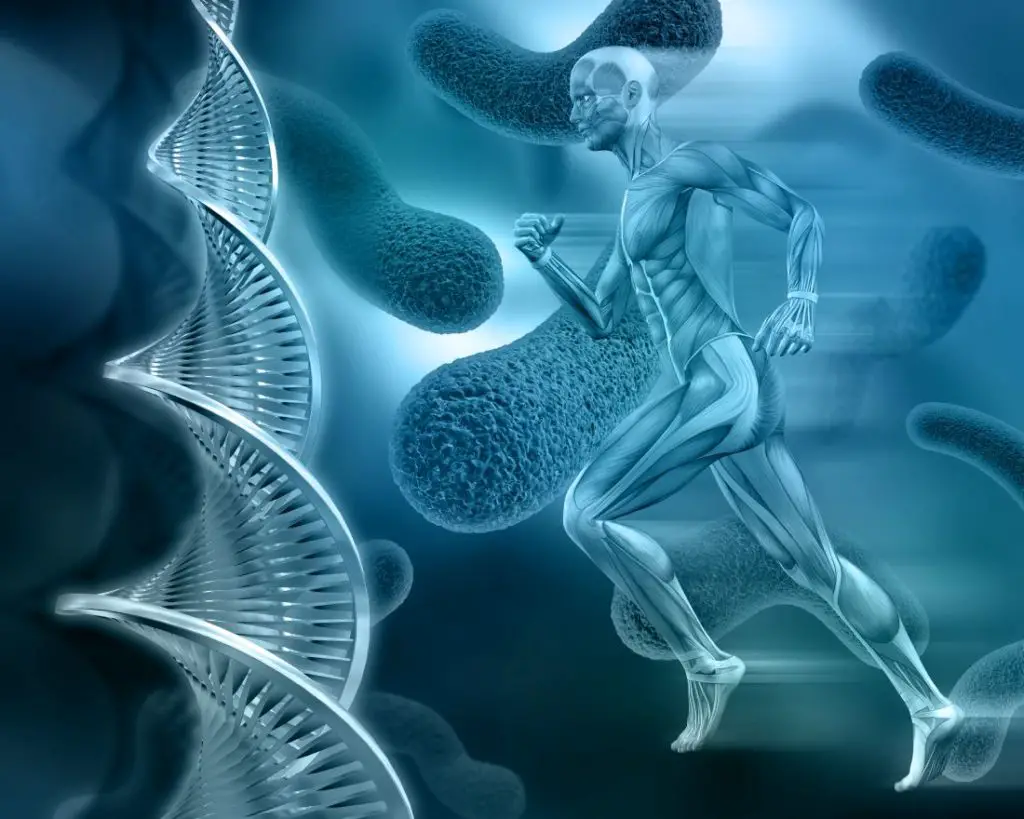
The rise in histamine may even account for some of the health benefits of exercise, as you’ll soon see. How do we know this?
Researchers from Ghent University in Belgium discovered that exercise training activates histamine receptors. In fact, activation of these receptors explains some of the health benefits of exercise, including the increase in stamina you get when you work out regularly. (“(“Regular HIIT Exercise Enhances Health via Histamine | The Scientist Magazine®” 2021)
The rise in histamine also explains some of the improvements in blood vessel health and insulin sensitivity you get when you work out regularly. So, histamine does some good things in response to exercise, but you don’t need the additional histamine if your histamine tank is already too full.
Working Out Intensely Can Trigger Histamine Intolerance Symptoms
And there are other reasons to be cautious. Having histamine intolerance may lead to a greater response to stress and exercise because anything that disrupts homeostasis and increases your body temperature triggers histamine production.
If your workout is vigorous or you exercise in a hot or humid setting, your body temperature can rise significantly. What does that lead to? More histamine release! Plus, you already have a harder time clearing the histamine your body produces. So, it’s double trouble!
Mast cells that release too much histamine can cause symptoms such as wheezing, shortness of breath, coughing, and flushing. Since exercise boosts the release of histamine, all of these unpleasant symptoms can occur when you’re working out or shortly after you stop.
Plus, skeletal muscles contain H1 and H2 receptors that bind to histamine. When mast cells embedded within muscle tissue release histamine, it binds to these receptors, and you get a histamine response. When you work your muscles at a high intensity, you create small tears in muscle fibers that trigger your body’s immune response and histamine release.
Plus, research shows histamine plays a role in muscle fatigue to prevent damage to the muscle from overuse. (Endo, Y., Tabata, T., Kuroda, H., Tadano, T., Matsushima, K., & Watanabe, M. (1998)
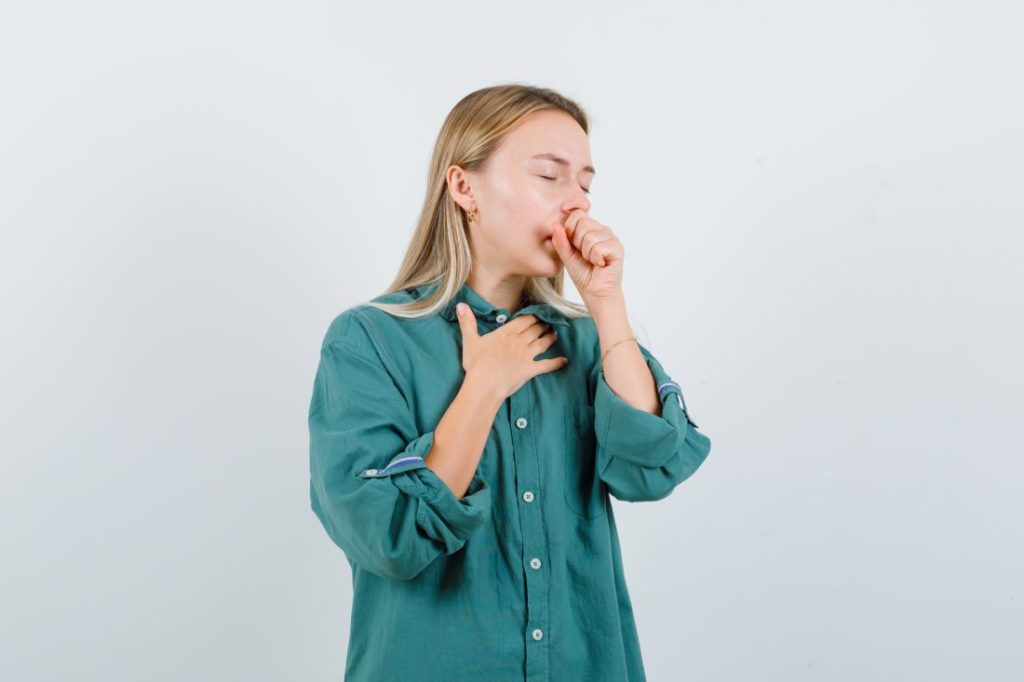
Aerobic exercise is the form of exercise that’s more likely to trigger histamine sensitivity symptoms, and the more intense the workout, the more likely histamine will build up enough to cause histamine intolerance symptoms.
Does Exercise Reduce Histamine Longer Term?
Based on these findings, you might think that exercise is not an option if you have histamine intolerance. However, regular exercise has an anti-inflammatory effect that may be beneficial if you keep the intensity lower. It’s the anti-inflammatory effect of exercise that may be beneficial if you have histamine intolerance.
Fast Fact:
Some people joke that they are allergic to exercise, but it’s not impossible. There is a condition called exercise-induced anaphylaxis, which is an allergy to exercise. ((“Exercise-Induced Anaphylaxis: Background, Pathophysiology, Epidemiology” 2021)) Approximately 2% of people suffer from this condition, and their symptoms are caused by the release of histamine.
Antihistamines Before Exercise: Are They Beneficial?
People often think that taking an antihistamine before an exercise session will counteract histamine release during exercise. It may not be a good idea for a number of reasons. Depending on the type you take, antihistamines can cause dizziness, drowsiness, dry mouth, and difficulty balancing. When you exercise, you don’t want that.
There’s also evidence that taking antihistamines can interfere with some of the benefits you get from working out. The gene response to exercise is enhanced by some 3,000 genes, but with high doses of antihistamines, almost 27 percent of this response is muted. (Luttrell and Halliwill 2017)
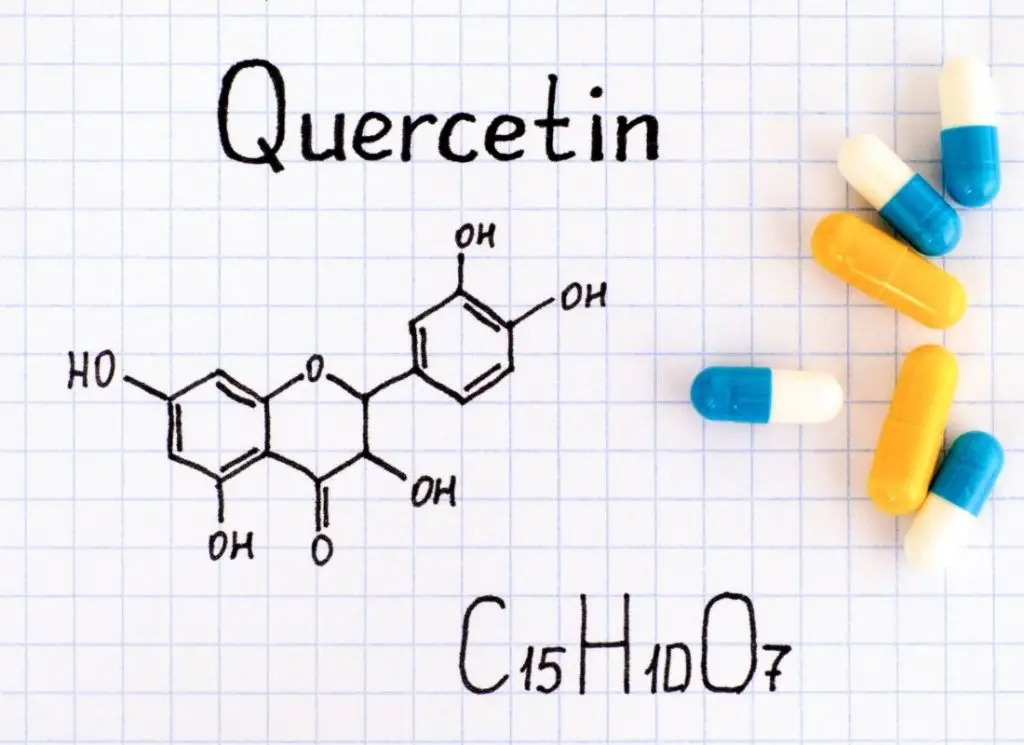
Quercetin as an Alternative to Antihistamines
So, antihistamines may blunt some of the health benefits you get from an exercise session. One alternative is to take quercetin in supplement form. Quercetin is a polyphenol, an anti-inflammatory compound, in some plant-based foods, like onions, apples, grapes, and green tea.
Quercetin has antioxidant and anti-inflammatory activity. It also reduces histamine release. Some doctors who take a more holistic approach recommend it to people who have asthma or seasonal allergies. (Mlcek et al. 2016)
We’ll talk more about quercetin and its effects later, but it might be helpful if you have histamine intolerance, even if you don’t exercise. Always talk to your doctor before starting a new supplement, though.
Choose Your Exercise with Care
Exercise is too beneficial to your health to ignore. Workouts of moderate intensity are also anti-inflammatory. (“Does Exercise Reduce Inflammation? Physical Activity and C-R…: Epidemiology” 2021)
So, moving your body regularly helps reduce inflammation and calm your immune system. That’s what you want if you have histamine intolerance. You don’t need to boost your body’s inflammatory burden or boost histamine release even more.
Still, it’s important to keep your body moving. Everyone needs movement to avoid losing muscle and bone tissue, but if you have histamine overload, the type of exercise you do matters. A hardcore or very intense workout where you sweat and can’t catch your breath isn’t smart and may aggravate your histamine intolerance symptoms.
Avoid High-Intensity Exercise
High-intensity interval training is all the rage, but it’s not for everyone. It’s not necessary to do that to reap the health benefits of exercise.
Why are vigorous workouts problematic? The amount of histamine you release during a workout is proportional to the intensity of your workout, according to a study conducted on animals in the 1930s.
So, dialing back the intensity of your exercise sessions should help you avoid worsening your histamine intolerance symptoms. That’s why it’s important to monitor the intensity of your workouts and your symptoms.
It makes sense that vigorous exercise would exacerbate symptoms related to histamine intolerance. When you exercise and stress your muscles, small microtears form in the muscle fibers. Immune cells, including mast cells, rush to the scene of the injury as part of the body’s attempt to repair those tears.

So, it’s best to keep the intensity low when you exercise and choose the most pleasant environment to exercise in. Start by taking a leisurely walk outdoors. Exercising in nature has added benefits since looking at nature has a calming effect on your brain and immune system. A leisurely bike ride is another option.
If it’s hot or humid outside, take your workout indoors. The heat and humidity can aggravate your symptoms.
One option that works for some people with histamine intolerance during the summer is to watch a video where you walk a mile or two indoors by walking in place. Google “Leslie Sansone.” She offers a variety of walking in place videos.
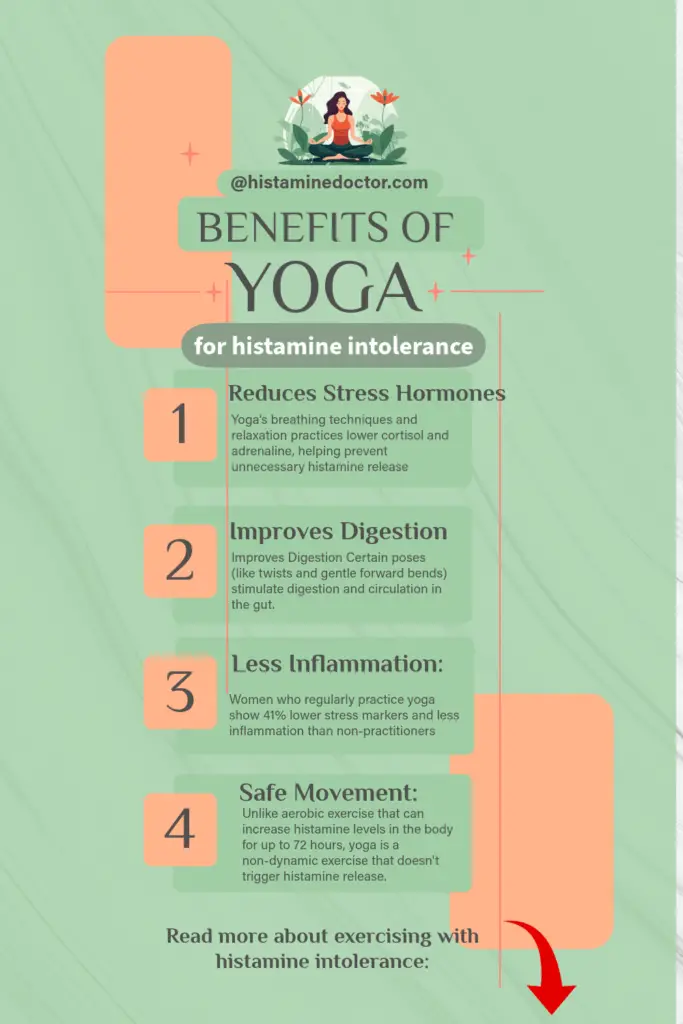
Yoga May Be Beneficial for Histamine Intolerance
Yoga is a mind-body workout that helps relax your mind and body.
Did you know that in one study, yoga practitioners had 41% lower stress levels than non-yogis who did not practice yoga? (Moliver et al. 2013) Plus, yoga may reduce inflammation. That’s a benefit, but it’s even more important if you have histamine intolerance.
What about studies looking at the effects of yoga on people who have histamine intolerance? Unfortunately, I couldn’t locate one. However, one study showed that pranayama yoga breathing increased the amount of histamine asthmatics needed to develop asthma symptoms. ((Singh et al. 1990))
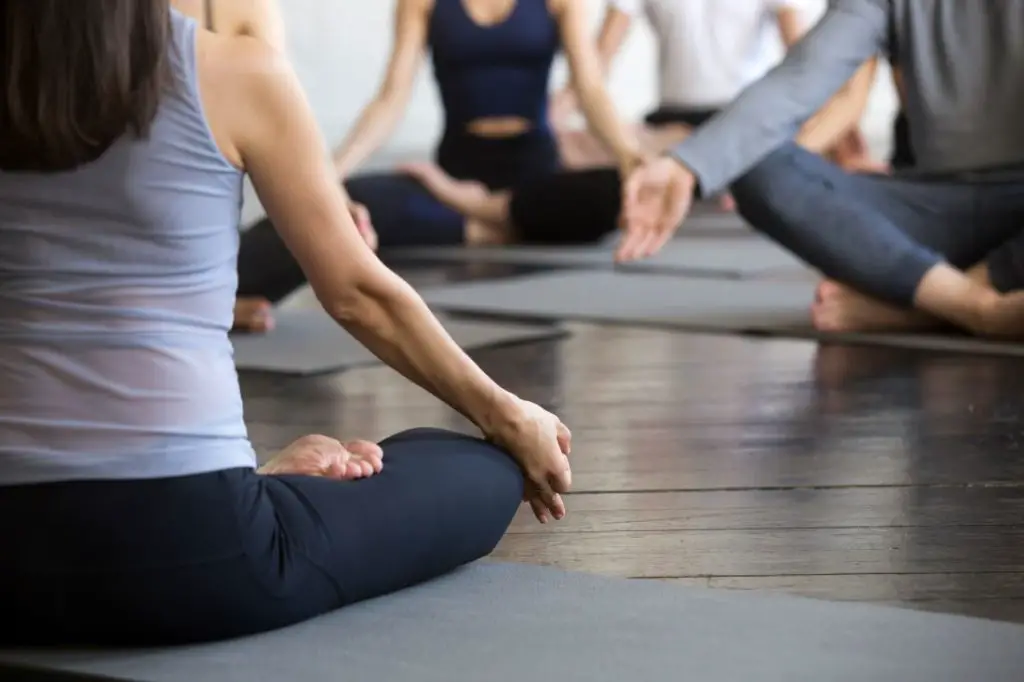
This research suggests that the breathing, or pranayama, that you do during yoga may reduce the body’s histamine burden. Combine that with the mind-body and relaxational benefits of yoga, and it may be a good option if you have histamine sensitivity.
It’s trendy right now but avoid hot yoga. Heat can trigger histamine release and worsen your symptoms. In fact, you may benefit from taking a cool shower after a yoga session or any other workout to lower your body temperature.
Watch What You Eat Before Exercising
What you eat before a workout matters too if you have histamine sensitivity. It’s a given that you want to avoid foods high in histamine before a workout. However, you should also avoid consuming caffeinated beverages since they can further raise your heart rate.
There are lots of caffeine sources that people forget about. Coffee, tea, energy drinks, and soft drinks are common sources of caffeine. Some over-the-counter medications for headaches also contain caffeine.
Chocolate contains small amounts, too. Chocolate also contains theobromine, a compound that can trigger histamine release. A mocha packs a double whammy in its effects on histamine intolerance!
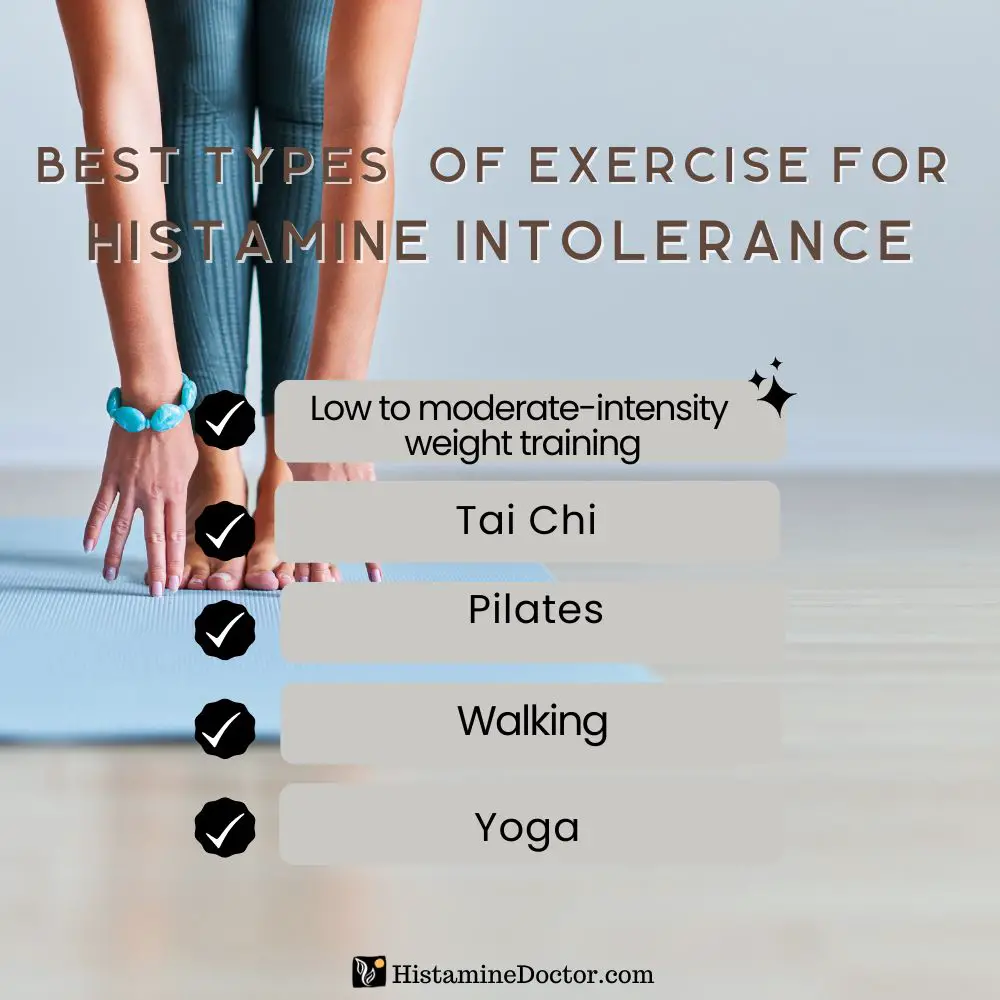
Can Exercise Help Histamine Intolerance?
Light to moderate intensity exercise is beneficial for your mind and body but you have to listen to both. If you have histamine intolerance, rest and recovery between workouts are crucial. You need time afterward for your nervous system and immune system to calm down, and for your histamine levels to fall.
Also, don’t overdo your exercise. Work out three times a week, so you have a rest day between exercise sessions to let your body recover and your histamine levels drop.
Take extra steps after each workout to cool down. Slowly reduce the intensity of your movement and spend more time stretching. Take a cool shower to bring your body temperature back down. A relaxing massage is another good idea if you have the time.
Also, keep a fitness/symptom journal where you write down the specifics of your workout, such as how long you exercised, what you did, and symptoms you experienced during or after. You can fine-tune your exercise sessions based on the symptoms you have.

Can Exercise Help Histamine Intolerance?
Exercise is a great way to improve your physical and mental health, but it can have the opposite effect if you have histamine intolerance and don’t do it in a healthy way. Stick with low-intensity exercise until you see how your body responds to working out.
More Tips for Exercising with Histamine Intolerance
- Dress in light, all-cotton clothing that “breathes” to reduce overheating, and choose your environment wisely.
- Don’t head outside on a hot, humid day and walk. It might be better to take a walk first thing in the morning or in the evening after it cools off.
- Always do a 10-minute warm-up where you gradually increase the intensity of your workout.
- After your workout is over, cool down SLOWLY. It’s important that you let your heart rate gradually come down. Don’t plop down in a chair right away
- Don’t forget about hydration! Water is fine if you’re exercising for less than an hour. If longer, sip a drink that contains electrolytes. Coconut water is a safe option if you have histamine intolerance. It’s an excellent source of potassium, too.
- Stay active, but make sure you’re doing it safely and aren’t aggravating your symptoms.
- Vary the types of workouts you do. Alternate walking and strength training with exercise that help you relax and recover, like yoga.
Remember, histamine intolerance is a unique journey for each individual. It may take time to find the exercise routine and dietary plan that work best for you. Be patient with yourself, and consult with a healthcare professional if you have specific concerns or questions about managing histamine intolerance while staying active.
References:
- Does Exercise Reduce Inflammation? Physical Activity and C-R…: Epidemiology. 2021. June 17. https://journals.lww.com/epidem/Fulltext/2002/09000/Does_Exercise_Reduce_Inflammation__Physical.12.aspx?WT.mc_id=HPxADx20100319xMP.
- Exercise-Induced Anaphylaxis: Background, Pathophysiology, Epidemiology. 2021. June 17. https://emedicine.medscape.com/article/886641-overview.
- Luttrell, Meredith J, and John R Halliwill. 2017. The Intriguing Role of Histamine in Exercise Responses. Exercise and Sport Sciences Reviews 45 (1). doi:10.1249/JES.0000000000000093. https://pubmed.ncbi.nlm.nih.gov/27741023/
- Mlcek, Jiri, Tunde Jurikova, Sona Skrovankova, and Jiri Sochor. 2016. Quercetin and Its Anti-Allergic Immune Response. Molecules 21 (5). doi:10.3390/molecules21050623.
- Physical Activity at Any Intensity Linked to Lower Risk of Early Death | BMJ. 2021. June 17. https://www.bmj.com/company/newsroom/physical-activity-at-any-intensity-linked-to-lower-risk-of-early-death/.
- Regular HIIT Exercise Enhances Health via Histamine | The Scientist Magazine. 2021. June 17. https://www.the-scientist.com/news-opinion/regular-hiit-exercise-enhances-health-via-histamine-68697.
- Singh, V., A. Wisniewski, J. Britton, and A. Tattersfield. 1990. Effect of Yoga Breathing Exercises (Pranayama) on Airway Reactivity in Subjects with Asthma. Lancet (London, England) 335 (8702). Lancet. doi:10.1016/0140-6736(90)91254-8.
- Mlcek, Jiri, Tunde Jurikova, Sona Skrovankova, and Jiri Sochor. 2016. Quercetin and Its Anti-Allergic Immune Response. Molecules 21 (5). doi:10.3390/molecules21050623.
- Endo, Y., Tabata, T., Kuroda, H., Tadano, T., Matsushima, K., & Watanabe, M. (1998). Induction of histidine decarboxylase in skeletal muscle in mice by electrical stimulation, prolonged walking and interleukin‐1. The Journal of Physiology, 509. https://doi.org/10.1111/j.1469-7793.1998.587bn.x.
‘

